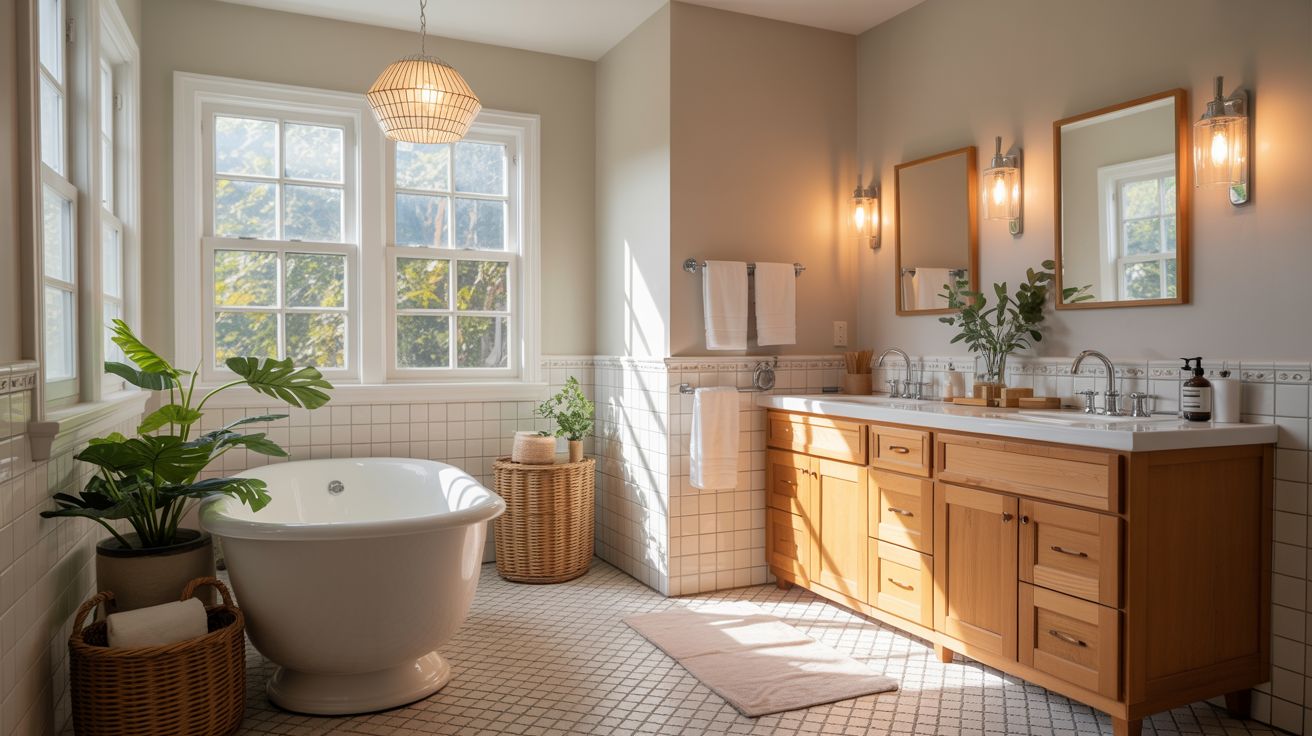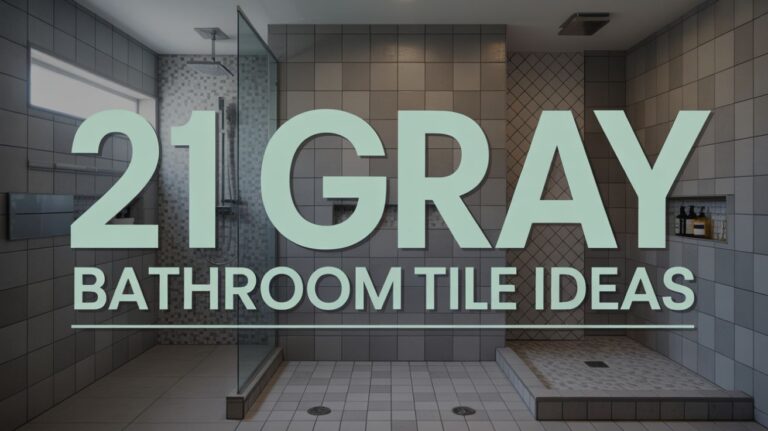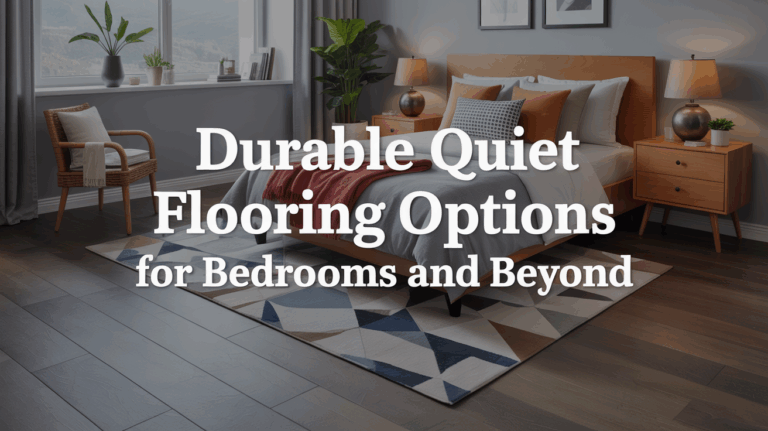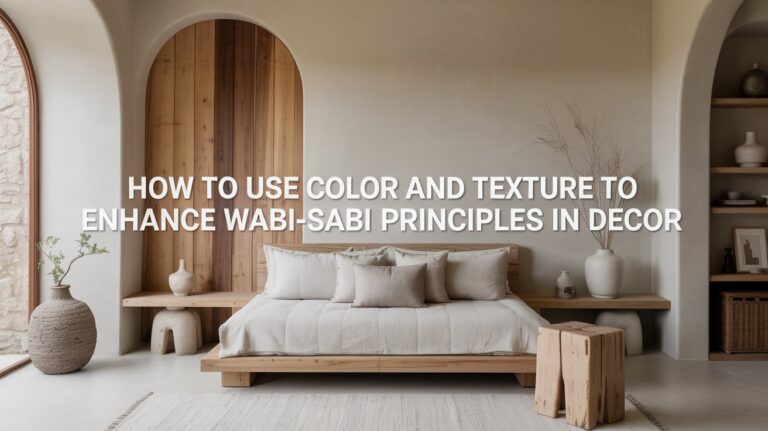The Benefits of Natural Light in Bathroom Design and Ways to Enhance It
I have been, or can be if you click on a link and make a purchase, compensated via a cash payment, gift, or something else of value for writing this post. As an Amazon Associate, I earn from qualifying purchases. Please read my full Affiliate Disclosure for more information.
Natural light transforms your bathroom by boosting brightness, color accuracy, and perceived space, while cutting the need for artificial lighting and guiding your design choices. It enhances mood, reduces clutter, and highlights fixtures with better visual hierarchy. To maximize it, use strategic window placement, frosted or clerestory glazing, and skylights or light tunnels for deep daylight. Reflective surfaces and pale, cool tones amplify brightness, while proper ventilation preserves comfort and longevity. Continue to optimize for even, glare-free illumination and seal the design’s potential.
Key Takeaways
- Natural light enhances bathroom ambiance, making spaces feel larger, warmer, and more inviting while reducing perceived clutter.
- Daylight improves color accuracy and fixture visibility, aiding task lighting and visual hierarchy throughout the day.
- Strategic window design (placement, height, glazing, skylights) maximizes daylight while balancing privacy and energy efficiency.
- Reflective surfaces and light colors amplify brightness, distribute light, and create depth without glare.
- Maintenance-focused choices (non-porous materials, proper venting, easy-clean finishes) sustain brightness, hygiene, and longevity.
How Natural Light Transforms Bathroom Ambiance
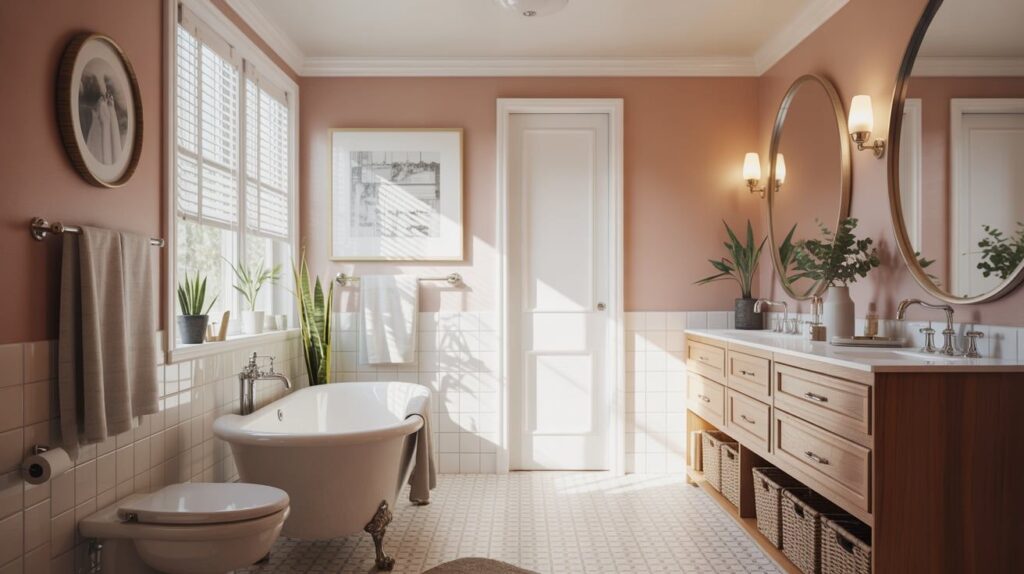
Natural light shapes bathroom ambiance by blending warmth with clarity, making spaces feel larger and more inviting. You’ll notice how daylight reduces perceived clutter, guides task lighting, and highlights fixtures. This transformation hinges on practical factors: orientation, window size, and glazing choices that modulate glare without sacrificing brightness. Proper bathroom ventilation prevents humidity build‑up that dulls perception, while well‑placed exhausts maintain a fresh feel after showers. Plumbing fixtures gain visual hierarchy when natural light emphasizes lines and finishes. In controlled daylight, you optimize color accuracy and reflectance, achieving a balanced, functional environment that remains comfortable across the day.
Color and Texture: Light’s Role in Perception
Color and texture respond directly to light, shaping how you perceive space, material richness, and functional cues in the bathroom. Light alters color accuracy, saturation, and warmth, influencing your sense of scale and daylight comfort. Color influence governs mood, contrast, and perceived size, guiding tile choices, cabinetry, and fixtures for legibility and harmony. Texture perception depends on shadow, specular highlights, and surface roughness, affecting tactile quality and maintenance cues. In design, balance luminous intensity with matte and glossy finishes to reduce glare while enhancing depth. Your selections should align with daylight behavior, durability, and easy interpretation of material semantics.
Maximizing Daylight: Window and Glass Options
Optimal daylight starts with smart window placement that captures morning and afternoon sun while preserving privacy. Consider window height, orientation, and multi-pane arrangements to maximize natural light without overheating, and pair with glass options that balance glare control and energy efficiency. Explore glass choices and configurations that support daylighting goals, from transom and clerestory heights to frosted and low-iron options for uninterrupted brightness.
Window Placement Strategies
Window placement matters because it controls daylight distribution, privacy, and heat gain. You optimize daylight by aligning openings with wall planes that receive morning or afternoon sun, avoiding glare on mirrors and screens. Use vertical or clerestory windows to boost vertical daylighting without sacrificing privacy. Consider room function: showers benefit from higher opening height, while vanities benefit from lower, eye-level light without direct exposure. Shading devices, such as adjustable blinds or frosted panes at strategic heights, support natural light control while maintaining privacy. Plan enclosure setbacks and interior layouts to reduce heat loss, maximizing comfort and energy efficiency. window placement supports natural light control.
Glass Options for Daylight
What glass options best maximize daylight without compromising privacy or energy efficiency? You’re balancing brightness with privacy and heat control. Frosted glass diffuses light while preserving visibility boundaries, ideal for sinks or showers where you want soft illumination without full exposure. Tinted glass reduces solar gain, lowering cooling needs without dramatically decreasing daylight, suitable for south-facing windows. Consider low-emissivity coatings to improve insulation without sacrificing clarity. Opt for laminated glass for safety in bathrooms, combining durability with light transmission. Pair with strategically placed operable panels or skylights to maintain ventilation. Select appropriate frame materials and seals to prevent drafts.
Privacy Without Sacrificing Brightness
Hidden window options and light-permitting privacy features let you keep daylight flowing while maintaining seclusion. Consider high-attenuation glass, frosted or etched finishes, and strategic placement to shield views without dimming interiors. These approaches support bright bathrooms by balancing visibility, glare control, and code-compliant privacy.
Hidden Window Solutions
Hidden window solutions let you keep natural light while preserving privacy. You’ll explore options that maximize brightness without exposing daily routines. Frosted glass panels scatter light softly, maintaining visibility limits and reducing glare. Translucent films offer adjustable opacity, letting you tune privacy per room use. Windowless design concepts leverage interior courtyards, skylights, or light tubes to deliver daylight deeper into the bathroom without external exposure. Consider vertical louvers or operable shutters behind frosted panes for controlled openness. Guarantee glazing meets privacy codes and energy performance. These solutions balance brightness, simplicity, and privacy in a modern, functional bathroom.
Light-Permitting Privacy Options
Natural light and privacy can coexist in the bathroom with options that filter brightness without exposing daily routines. You’ll balance light and discretion by selecting materials that transmit visibility while diffusing details. Privacy curtains offer adjustable coverage, allowing you to modulate glare without sacrificing daylight. For a permanent solution, frosted glass obscures anatomy while maintaining translucence, enabling even illumination across surfaces. Consider laminated or frosted films on existing panes for cost-effective customization. Ventilation remains essential to prevent humidity-related haze. Pair these options with strategically placed mirrors and skylights to maximize perceived brightness while preserving privacy throughout the space.
Skylights and Light Tunnels: Creative Solutions
Skylights and light tunnels offer practical ways to bring daylight deep into bathrooms, reducing electrical use while enhancing mood and perceived space. You’ll evaluate skylight installation options, considering roof structure, flashing, and energy ratings to prevent leaks. Light tunnel design compresses daylight through a distant, reflective conduit, delivering consistent brightness without direct glare. Assess daylight factor and placement to maximize reach in showers and vanities. Insulation, UV protection, and condensation control are essential for performance and longevity. Maintenance should be simple access and clear screens. Pair with automated dimming or sensors for efficient, comfortable illumination throughout the day.
Reflective Surfaces and Light Distribution
In bathrooms, reflective surfaces redirect daylight and artificial light to brighten corners, reduce glare, and expand perceived space. You optimize light distribution by selecting high-reflectance materials and strategic placements. Mirror placement matters: larger, well-centered mirrors amplify both natural and artificial light, creating an even, luminous feel without adding clutter. Pair mirrors with polished or lightly textured surfaces to avoid hotspots. Wall color influences bounce; choose pale, cool tones for brightness or subtle warm shades for comfort, ensuring contrast remains readable. Avoid heavy textures near primary light sources; instead, favor smooth finishes that reflect rather than absorb.
Energy Efficiency and Maintenance Benefits
Efficient lighting and thoughtful material choices in a bathroom design cut energy use and simplify upkeep. Natural light reduces reliance on artificial lighting during daytime, delivering energy savings while maintaining visibility for daily tasks. Choose high-transmittance, low-bleed glazing and properly sealed windows to minimize heat loss and drafts. Pair with efficient LEDs and smart dimming to preserve daylight without waste. Materials should resist moisture and staining, lowering maintenance frequency; use non-porous surfaces and easy-clean finishes. Regular seals, venting, and glow-resistant fixtures prevent mold and degradation. Together, these strategies provide energy savings and low maintenance without compromising comfort or style.
Conclusion
You’ll see how natural light reshapes your bathroom’s mood and function. By prioritizing window placement, glass choices, and reflective surfaces, you’ll boost brightness without sacrificing privacy. Skylights and light tunnels expand daylight reach, while smart layouts prevent glare and heat gain. Energy efficiency improves with efficient glazing and properly sealed assemblies, and maintenance stays simple with durable materials. In short, thoughtful light strategy elevates ambiance, usability, and long-term costs in a single, cohesive design choice.
